- Also see: Evolution
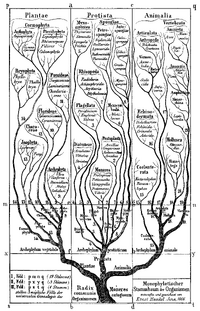
Ernst Haeckel's "Tree of Life" (1866)
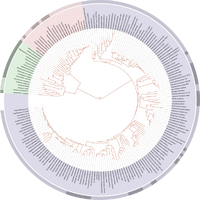
A modern phylogenetic tree
Phylogeny is the history of development, adaptation, branching and evolutionary relations of living organisms. The graphs appear as branched lines that start from a common origin and produce more and more lines; the end result look like a tree or shrub, so this graphs are called phylogenetic trees.
Nested Hierarchies[]
An obvious consequence of evolution, since every natural group of species traces back its origins to a single ancestor species, is that living beings can be classified in categories based on their ancestry. If the ancestor A produced the two species B and C, we can classify their descendants in the groups "B descendants" and "C descendants", and both groups will be part of the larger group "A descendants". The species at the root of each category (which is still only a part of an even greater category) is called common ancestor or concestor.
The first rational method of classification, Linnaean taxonomy (explained in detail here) bestowed each category with a precise hierarchic rank: the ones introduced by Linnaeus were kingdom, class, order, genus, and species. Later, two other main ranks were added: phylum and family, and later secondary intermediate ranks, such as tribe and subfamily. For example, humans belong to the species Homo sapiens, which is in the genus Homo, which is in the family Hominidae, which is the order Primates, which is in the class Mammalia, which is in the phylum Chordata, which is in the kingdom Animalia. All Hominidae (and other families) are Primates, all Primates (and other orders) are Mammalia, and so on. Such categories (called taxa, singular taxon) share common traits inherited by their common ancestor (see more below).
There is, though, a case where the rule of nested hierarchies is broken: horizontal gene transfer, that is, the flow of genes between two individuals that are not parent and offspring. It's very common among bacteria, since their genetic material is organized in only one chromosome and isn't enclosed in a nucleus, but in eukaryotes is extremely rare. Known example include genes of beer yeast extracted from bacteria, a gene to synthetize carotenoids passed from a fungus to the aphid Acyrtosiphon pisum[1] and some transfers between parasite and host (the grass Striga hermontica from sorghum, Rafflesiaceae from trees and maybe the malaria pathogen Plasmodium vivax from humans)[2].
[]
A biological trait is any possible variation of a character, be it determind by genes, by the environment or both; if, say, the nature of limbs is a character, whether they're legs, arms, wings, fins, maxillae, chelipeds, pedipalps, etc. are all traits. Major morphological traits tend to be conserved through time, so all the descendants of a species will inherit several traits from it; the taxon that descends from this species will have one or more shared traits that will be present in most, if not all, its members. For example, the shared traits of mammals are fur, four limbs (both lost in whales), lactation, homeothermy, three bones in the middle ear, a lower jaw formed by only one bone, and so on.
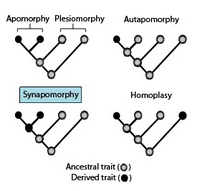
Types of biological traits
Three types of traits can be recognised, according to their distribution:
- Plesiomorphic traits are inherited from the ancestors. They're not defining traits of a group that inherited them, since other groups have inherited the same traits.
- Apomorphic traits are newly developed in a group. They are true defining traits, as they arose in that group's ancestral species. When one species develops an apomorphy, all the variations of that same trait found in its descendant are called synapomorphy.
- Homoplasic traits have arisen independently in unrelated groups. They can be described as two or more apomorphies that just happened to be similar, but they do not define a group, as they didn't arise in one ancestral species, but in several.
For example, in mammals mammary glands are synapomorphic (they appeared in the ancestral mammal and were inherited by its descendants), four limbs are plesiomorphic (they existed well before the ancestral mammal, and their original developer transmitted them to amphibians and reptiles too), and homeothermy is homoplasic (it also appeared in birds, and it's probably plesiomorphic both for the ancestral mammal and the ancestral bird).
Cladistics[]
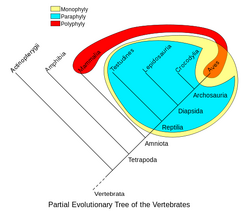
Example of cladogram
Modern cladistics has replaced Linnaean taxonomy. It's very similar on most accounts, but it does away with the hierarchic rank, as categories can be nested indefinitely: Aves (birds), a class, can be nested inside Saurischia (reptile-hipped dinosaurs), an order. Here, the only valid groups are called clades, and they have to contain every descendant of an ancestor species and nothing else. Relationships between clades are visualized as lines and nodes through graphs called cladograms; note that the actual distance between nodes is irrelevant, and only the pattern of connections actually matters.
Taxa can now be classified in three types:
- Monophyletic (or holophyletic) groups include a species, all its descendants and nothing else. They share synapomorphies derived from that ancestral species, and they represent a clade.
- Paraphyletic groups include a species and some of its descendants, but not all of them. "Reptiles" are a paraphyletic group, since they include lizards and crocodiles but not birds, despite the fact that birds are closer to crocodiles than lizards are; such groups share a synapomorphy, but exclude another group with extra synapomorphies. Other examples are "fish", "invertebrates", "algae", "microbes"; they do have a phylogenetic meaning (see below) but they're not clades and they shouldn't have an official name.
- Polyphyletic groups include different species but not their last common ancestor, nor other descendants of it. They can be recognized through homoplasies, for example the wings of bats, pterosaurs and birds (the last common ancestor of bats, pterosaurs and birds didn't have wings, and thus the "winged vertebrate" group is polyphyletic). As with paraphyletic groups, polyphyletic groups are not clades.
Cladistic Groups[]
Cladistics has introduced a greater variety of groups that can be useful to describe the relationship of organisms through time, though they do not always correspond to clades.
- A crown group contains at least two living species, their most recent common ancestor and all the descendants of this ancestor. It's a clade. For example, the most recent common ancestor of Homo sapiens and Ornithorhynchus anatinus defines Mammalia as a crown group.
- A pan-group or total group contains a species and all the organisms that are closer to this species than to another one, including extinct species that wouldn't belong to a crown group. It's a clade. For example, all species closer to Passer domesticus than Alligator sinensis would define Avemetatarsalia, including birds, non-avian dinosaurs, and pterosaurs.
- A stem group contains all the species closer to A than to B, but not A itself; it's essentially a pan-group deprived of a crown-group. It's a paraphyletic group, and thus not a clade. For example, "Mammal-like reptiles" can be defined as all species closer to Mammalia than Passer domesticus, but excluding Mammalia.
- A zygon group contains a crown group, the second crown group closest to the first one and their common ancestor (with all of its descendants). It's a clade. For example, crown group Mammalia and crown group Sauropsida, their common ancestor, and all descendants defines Amniota.
- A plesion group is the not-crown group closest to a crown group (sister clade). It can be a clade or not. For example, the plesion group to Aves is likely to be the Deinonychosauria.
- A scion group contains a crown group, a certain number of plesion groups and their common ancestor (with all of its descendants). It's a clade. For example, Cynodontia includes Mammalia and a paraphyletic group including many mammal-like cynodonts which are not counted as mammals.
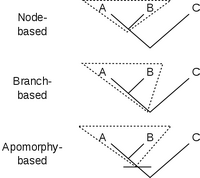
The three types of clades.
There are three ways to define a clade: a node-based clade (a crown group) is the least inclusive clade that includes both A and B: its common ancestor is the last common ancestor of A and B. A branch-based clade is the most inclusive clade that includes A but not C: its common ancestor is the earliest ancestor of A that is not also ancestor of C. An apomorphy-based clade is a clade distinguished by an apomorphy: its common ancestor is the earliest species that develops that particular apomorphy.
Clades and Grades[]
When a crown group introduces particularly noticeable synapomorphies, the branches in its stem group can appear very different from it, though some of them are closer to it than others are. For example, Ornithomimidae and Troodontidae look very similar to each other, and inherited their similar traits from a common ancestor; despite this, Troodontidae is closer to birds than to Ornithomimidae.[3]
When the taxonomy of a radiation of species through time is considered, the concept of grade is introduced: it's a paraphyletic mixture of stem groups and crown groups characterized by one or more synapomorphies. For example, "fish", "amphibian" and "reptiles" are evolutionary grades in the history of vertebrates: fish are distinguished by features such as fins and gills, though there isn't a "fish clade" (as some fish are closer to tetrapods than to other fish); "reptiles" have a number of features (scaly skin, calcareous eggs, ectothermy) that are not found in birds or mammals, while any meaningful "reptile clade" should, in fact, include at least birds.
Phylogenetic Trees in Speculative Biology[]
Writing down a phylogenetic tree is strongly recommended in speculative biology projects, especially in the field of exobiology, as they keep a record of the relationship among the groups and their development through deep time.
Examples[]
- Gossipiboma Cladogram
- Phylogenies of life on Ilion (scroll down)
Notes[]
- ↑ Nancy A. Moran and Tyler Jarvik, "Lateral Transfer of Genes from Fungi Underlies Carotenoid Production in Aphids", Science, 30 April 2010. <http://www.sciencemag.org/content/328/5978/624.abstract>
- ↑ Daniel Z. Bar, "Evidence of Massive Horizontal Gene Transfer Between Humans and Plasmodium vivax", Nature Precedings, 16 February 2011. <http://precedings.nature.com/documents/5690/version/1/>
- ↑ "Grade and Clade - Horizontal and Vertical Classification", Palaeos, May 26 2002. <http://palaeos.com/phylogeny/evolutionary/grade_and_clade.html>
